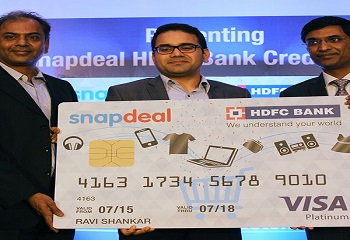Country’s second largest private sector lender, HDFC Bank and online e-retailer Snapdeal which is owned and operated by Jasper Infotech jointly launched co branded e-commerce credit card on 3rd Aug, 2015. According to Snapdeal, over 70% of its customers are from tier-2 and tier-3 cities and a majority of them opt for cash-on-delivery service and only a small portion of them opt for digital payment methods. The credit cards that the online marketplace and the financial institution will launch, will target these buyers in smaller towns and cities, the officials added. Though the officials from HDFC Bank and Snapdeal confirmed the tie-up, they refused to share the details of the partnership except that the cards are expected to be rolled out over the next four to six weeks.
As per the tie up, a customer can apply for the card from Snapdeal’s website, mobile site or even from the mobile app. The applicant’s credit eligibility will be checked instantly. Even non customers of the bank can apply for the co-branded credit card. The move is aimed at tapping the rise in ecommerce transactions with payments companies like Paytm which gives discounts to attract customers.
“This card will cater to the changing needs and lifestyles of customers in tier 2 and 3 cities who can now use it to make all purchases, while availing of great value in the form of discounts, offers and rewards,” said Parag Rao, business head – card payment product & merchant acquiring services, HDFC Bank.
“The customer is at the centre of our ecosystem and this new initiative is aligned in this direction,” said Kunal Bahl, Co-Founder and CEO, Snapdeal.
As per a 2014 global consultancy report, while the number of debit cards in circulation in India has increased rapidly, credit card penetration, in comparison, has remain stagnant. The Snapdeal-HDFC deal could have significant benefits for the New Delhi-based e-commerce company, which sees a significant portion of its $3 billion annual gross merchandise sales generated from tier-III and IV towns and cities across the country, where credit cards and other forms of plastic currency have made little headway.
“For banks, it’s about the volume of transactions that can be potentially generated. For retailers, it’s about marketing and communications and about consolidating their share on certain spend,” said Gaurav Marya, Chairman, Franchise India Holdings, a leading consumer, brand and retail advisory firm.
Though e-commerce in India is driven by the cash-on-delivery mode of payment, it hurts the company’s bottom-line, given the high rate of returns that sometimes force companies to not only bump up their cost of restocking or relisting goods, but also write them off for good.





